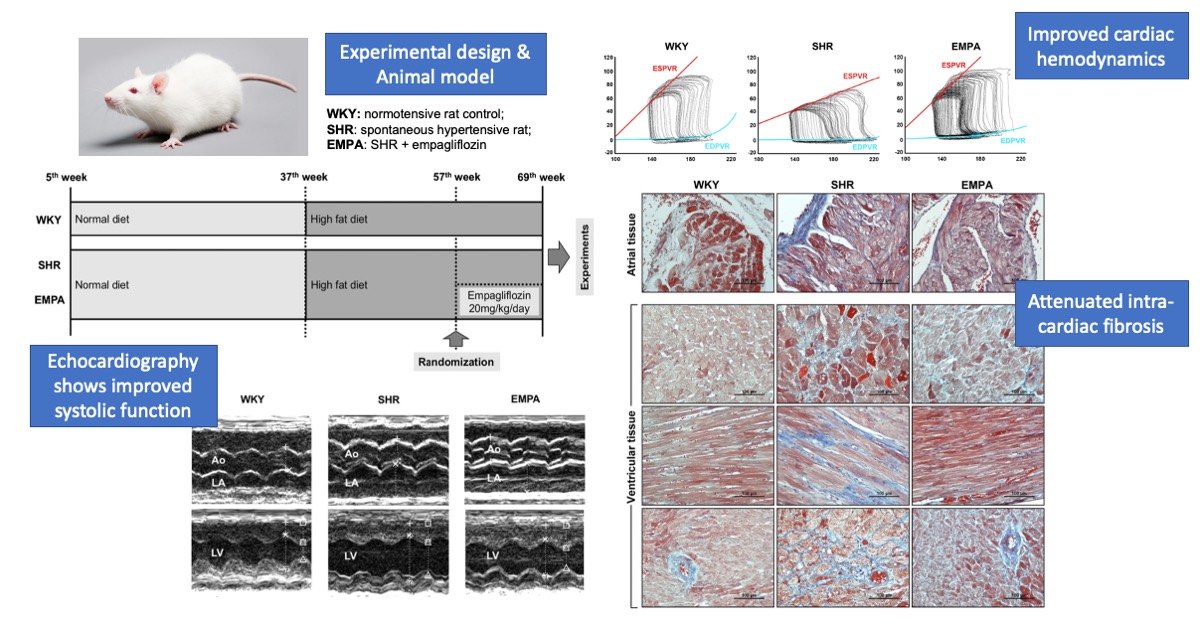降血糖藥「鈉-葡萄糖共同輸送器-2抑制劑」減輕高血壓心衰竭鼠之心肌內纖維化並改善心臟生理功能
降血糖藥「鈉-葡萄糖共同輸送器-2抑制劑」減輕高血壓心衰竭鼠之心肌內纖維化並改善心臟生理功能
鈉-葡萄糖共同輸送器-2抑制劑為新一代降血糖藥,作用機轉為抑制腎臟對葡萄糖的吸收,在臨床使用的觀察研究發現,亦可減少心血管死亡率和住院率,且此藥對心臟的保護作用,似乎與血糖獨立無相關,然而詳細機轉未明。
本研究利用具有高血壓的大鼠,餵食32週的高脂飼料後,發展出心室肥大、纖維化與心臟衰竭,為動物實驗模式。隨機分類,施予鈉-葡萄糖共同輸送器-2抑制劑 empagliflozin 藥物,為期共12週。實驗終止結束前,以心電圖、心臟超音波、與心室內心導管檢查,將心臟功能行全盤地評估。結果發現,empagliflozin改善心臟擴大與心臟收縮功能。血液分析發現,empagliflozin組之腎功能有顯著改善,對血糖值卻無顯著影響。高血壓與高脂食物造成之心臟組織中的纖維化程度與膠原蛋白增生,包括心房和心室組織裡,在empagliflozin組都有顯著改善。而分子層面的分析,則發現高血壓心衰竭鼠之心房與心室內具有PPARα、ACADM、natriuretic peptides (NPPA 與 NPPB)、TNF‐α等的上升調控,在empagliflozin組都有顯著改善。
簡言之,empagliflozin在高血壓心衰竭鼠的心房和心室組織中,改善心衰竭相關的分子訊號,減輕心臟組織內纖維化,而顯著改善心臟生理功能。這個研究對於我們進一步了解「鈉-葡萄糖共同輸送器-2抑制劑在改善心衰竭」的機轉上,有重要的幫助,過去醫學認知,心臟組織的纖維化為心肌受損、例如心肌梗塞後或老化過程所發生,一般相信纖維化大多為不可逆,此研究發現,心肌內的纖維化可以改善,而我們所發現的幾個相關分子訊號調控,將能衍伸出更多深入的分子機轉探討,對將來心受損後纖維化相關的心衰竭的治療標的,亦具有重要啟示性的貢獻。

圖說:左上,高血壓心衰竭鼠之動物實驗模式與鈉-葡萄糖共同輸送器-2抑制劑 empagliflozin 治療組之實驗設計;empagliflozin藥物治療效果部分以下說明:左下,心臟超音波檢查顯示左心房擴大的減輕與左心室收縮功能的增進;右上,心導管檢查顯示心臟生理功能改善;右下,組織切片染色顯示心房與心室心肌內纖維化的減輕。
本篇為高雄醫學大學2019年月傑出論文4月份得獎文章,代表作者為高雄醫學大學附設醫院心臟內科李香君主治醫師。
本校主要研究者之簡介:
李香君主治醫師/副教授
高雄醫學大學醫學院國際組組長;高雄醫學大學附設醫院心臟內科主治醫師;高雄醫學大學醫學系內科副教授;中山大學醫學科技研究所合聘副教授;美國心臟病協會國際會士
研究聯繫Email:
hclee@kmu.edu.tw
期刊出處:
Lee et al. Cardiovasc Diabetol (2019) April; 18:45
期刊線上參閱網址:
https://doi.org/10.1186/s12933-019-0849-6
The sodium–glucose co-transporter 2 inhibitor empagliflozin attenuates cardiac fibrosis and improves ventricular hemodynamics in hypertensive heart failure rats
The sodium–glucose co-transporter 2 inhibitor empagliflozin attenuates cardiac fibrosis and improves ventricular hemodynamics in hypertensive heart failure rats
Sodium glucose co-transporter 2 inhibitor (SGLT2i) is a new class of anti-diabetic drugs, and it acts on inhibiting glucose resorption by kidneys. Empagliflozin, one of SGLT2i in clinical use, has been shown beneficial in reduction of heart failure hospitalization and cardiovascular mortality. The heart protection effect seems independent from the blood glucose control. The protection mechanisms from SGLT2i to the heart remain unclear.
This study used a hypertensive heart failure animal model that was created by feeding spontaneous hypertensive rats (SHR) with high fat diet for 32 weeks. The elevated blood pressure and lipotoxicity caused atrial dilatation, left ventricular hypertrophy, intra-cardiac fibrosis and impairment of heart function. Half SHRs were randomized to be administered with SGLT2i, empagliflozin at 20 mg/kg/day for 12 weeks. Before the end of experiments, evaluation of electrocardiography and echocardiography, and invasive hemodynamic study were performed and followed by blood and tissue samples collection. The results showing benefits from empagliflozin in this hypertensive heart failure model are as following: (1) improved cardiac remodeling (improvement in atrial size and ventricular hypertrophy) ; (2) renal function improvement, while plasma glucose level unaffected; (3) normalization of both end-systolic and end-diastolic volume in SHR, in parallel with echocardiographic parameters improvement; (4) normalization of systolic dysfunction; (5) empagliflozin significantly attenuated cardiac fibrosis in both atrial and ventricular tissues; and (6) upregulation of atrial and ventricular expression of PPARα, ACADM, natriuretic peptides (NPPA and NPPB), and TNF-α in SHR, was all recovered by treatment of empagliflozin.
In short, empagliflozin improved atrial and ventricular remodeling, signaling pathways in heart failure, attenuated intra-cardiac fibrosis, improved hemodynamics in our hypertensive heart failure rat model. Our results contribute further understanding of the pleiotropic effects of empagliflozin regarding heart protection. The improvement of intra-cardiac fibrosis and the discovered modulated signaling pathway by empagliflozin will inspire more molecular biological studies, in order to find out more therapeutic targets for heart failure that is related to cardiac fibrosis.

Figure caption. Left upper. The experimental design for testing effects of empagliflozin on hypertensive heart failure model. The therapeutic effects are summarized as following: Left lower. Improvement of atrial and ventricular remodeling, and ventricular systolic function shown in echocardiography; Right upper. Improvement of cardiac hemodynamics in the empagliflozin group; Right lower: attenuation of intra-cardiac fibrosis in atrial and ventricular tissue histology.
Main researcher Intro.
Researcher:
Hsiang-Chun Lee, MD, MSc, PhD, FAHA
Director of Global Affairs, College of Medicine, Kaohsiung Medical University;
Cardiologist, Kaohsiung Medical University Hospital;
Associate Professor, Internal Medicine, School of Medicine, College of Medicine, Kaohsiung Medical University
Author Email
hclee@kmu.edu.tw
Paper cited from:
Lee et al. Cardiovasc Diabetol (2019) April; 18:45
Paper online website
https://doi.org/10.1186/s12933-019-0849-6

